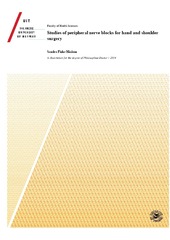| dc.contributor.advisor | Ytrebø, Lars Marius | |
| dc.contributor.author | Flohr-Madsen, Sandra | |
| dc.date.accessioned | 2019-05-08T08:02:19Z | |
| dc.date.available | 2019-05-08T08:02:19Z | |
| dc.date.issued | 2019-04-04 | |
| dc.description.abstract | Performing regional anesthesia with a minimum effective volume (MEV) of local anesthetic may reduce the risk of systemic local anesthesia toxicity. The lateral sagittal infraclavicular block (LSIB) is a well-established anesthesia method for surgery distal to the shoulder. For LSIB using ropivacaine 7.5 mg/ml the MEV was previously not known and we estimated MEV95 to be 31 ml (95% CI, 18 – 45 ml).
LSIB tends to result in supination of the hand/forearm, which may inhibit surgical access to the dorsum of the hand. Supination of the hand and forearm usually occurs by lateral rotation of the radius. When the upper limb is extended, supination may be obtained also by lateral rotation of the humerus. The main lateral rotator of the humerus is the infraspinatus muscle, innervated by the suprascapular nerve. In study II we hypothesised that this supination may be reduced by the addition of a suprascapular nerve block (SSNB) to the LSIB. The study showed that this combination provided a better hand/forearm position for dorsal hand surgery than LSIB alone.
Interscalene brachial plexus block (ISB) has been the gold standard for pain management in patients undergoing shoulder surgery. It has a very high success rate, but with a high incidence of phrenic nerve block. Diaphragm-sparing alternatives have therefore been investigated. In study II we applied SSNB primarily because we wanted to prevent lateral rotation of the humerus, but chest radiographs documented that the combination of LSIB and SSNB did not cause paresis of the diaphragm. In study III we hypothesised that the combination of superficial cervical plexus block, SSNB and LSIB would provide a good alternative to the ISB with a lower risk of phrenic paresis. The triple block was shown to be feasible for arthroscopic shoulder surgery. | en_US |
| dc.description.doctoraltype | ph.d. | en_US |
| dc.description.popularabstract | Regional anesthesia may be an alternative to general anesthesia for upper limb surgery. In our first study, we estimated the minimum effective volume of a local anesthetic (LA) for an infraclavicular block (LSIB, below the clavicle). Its guidance may help minimizing the risk of adverse reactions to LA. The infraclavicular block tends to rotate the hand/forearm outwards. This is awkward for surgery at the back of the hand. In study II, a suprascapular nerve block (SSNB, cranial to the clavicle) was added to the infraclavicular block improving the hand position. Interscalene block (neck level) is the standard peripheral nerve block for shoulder surgery. Due to associated risk of palsy of the diaphragm, alternatives have been requested. In study III we found that the novel block combination of a superficial cervical plexus block (neck level), SSNB, and LSIB provided good anesthesia for arthroscopic shoulder surgery patients. | en_US |
| dc.description | E-post til Sandra, har hun fått samtykke fra medforfattere nå? Ellers klar til å legge ut. 20190416 NC Epost til veilederen Ytrebø 20192904 NC. | en_US |
| dc.identifier.uri | https://hdl.handle.net/10037/15264 | |
| dc.language.iso | eng | en_US |
| dc.publisher | UiT The Arctic University of Norway | en_US |
| dc.publisher | UiT Norges arktiske universitet | en_US |
| dc.relation.haspart | <p>This thesis contains the following papers:
<p>Paper I: Flohr-Madsen, S., Ytrebø, L.M., Kregnes, S., Wilsgaard, T. & Klaastad Ø. (2013). Minimum effective volume of ropivacaine 7.5 mg/ml for an ultrasound-guided infraclavicular brachial plexus block. <i>Acta Anaesthesiologica Scandinavica, 57</i>(4), 495-501. Also available at <a href= https://doi.org/10.1111/aas.12078> https://doi.org/10.1111/aas.12078</a>. Accepted manuscript version available at <a href= https://hdl.handle.net/10037/15276> https://hdl.handle.net/10037/15276</a>.
<p>Paper II: Flohr-Madsen, S., Ytrebø, L.M., Valen, K., Wilsgaard, T. & Klaastad, Ø. (2016). A randomised placebo-controlled trial examining the effect on hand supination after the addition of a suprascapular nerve block to infraclavicular brachial plexus blockade. <i>Anaesthesia, 71</i>(8), 938-947. Also available at <a href=https://doi.org/10.1111/anae.13504>https://doi.org/10.1111/anae.13504</a>. Accepted manuscript version available at <a href= https://hdl.handle.net/10037/15278> https://hdl.handle.net/10037/15278</a>.
<p>Paper III: Musso, D., Flohr-Madsen, S., Meknas, K., Wilsgaard, T., Ytrebø, L.M. & Klaastad, Ø. (2017). A novel combination of peripheral nerve blocks for arthroscopic shoulder surgery. <i>Acta Anaesthesiologica Scandinavica, 61</i>(9), 1192-1202. Also available at <a href=https://doi.org/10.1111/aas.12948> https://doi.org/10.1111/aas.12948</a>. Accepted manuscript version available at <a href= https://hdl.handle.net/10037/15279> https://hdl.handle.net/10037/15279</a>. | en_US |
| dc.rights.accessRights | openAccess | en_US |
| dc.rights.holder | Copyright 2019 The Author(s) | |
| dc.rights.uri | https://creativecommons.org/licenses/by-nc-sa/3.0 | en_US |
| dc.rights | Attribution-NonCommercial-ShareAlike 3.0 Unported (CC BY-NC-SA 3.0) | en_US |
| dc.subject | VDP::Medisinske Fag: 700::Klinisk medisinske fag: 750::Anestesiologi: 765 | en_US |
| dc.subject | VDP::Medical disciplines: 700::Clinical medical disciplines: 750::Anesthesiology: 765 | en_US |
| dc.title | Studies of peripheral nerve blocks for hand and shoulder surgery | en_US |
| dc.type | Doctoral thesis | en_US |
| dc.type | Doktorgradsavhandling | en_US |


 English
English norsk
norsk

